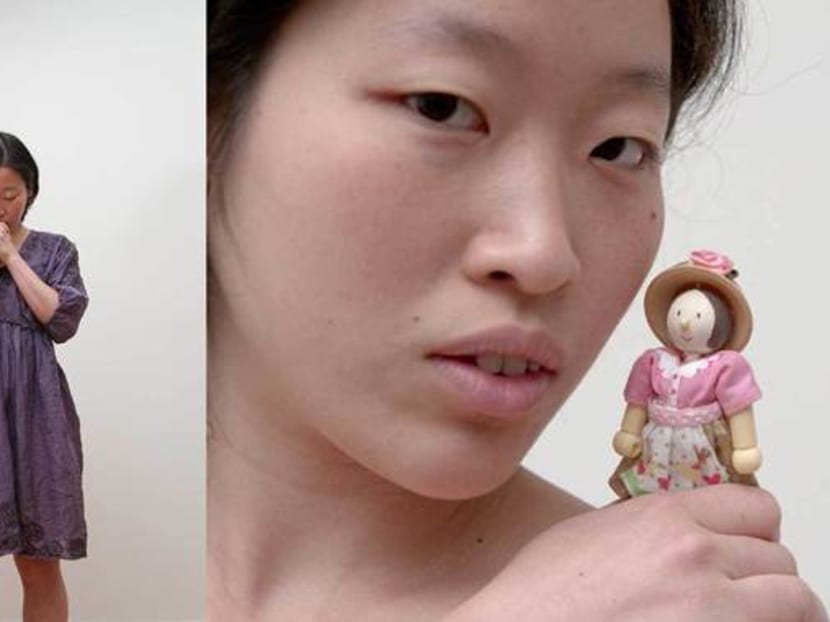In defense of No Star Arts Grant as performance
SINGAPORE — Love it or hate it, dance artist-slash-scientist Eng Kai Er’s No Star Arts Grant has certainly got people talking.

Dance artist (and scientist) Eng Kai Er, the artist behind No Star Arts Grant, also performed at the 2012 M1 Singapore Fringe Festival with a piece called The Prayer. Photo: M1 Singapore Fringe Festival.
SINGAPORE — Love it or hate it, dance artist-slash-scientist Eng Kai Er’s No Star Arts Grant has certainly got people talking.
It’s unfortunate, however, that majority of said talk — in the echo chamber of social media — has centred around personal attacks on Eng and her relationship to A*Star, and the issue of scholarships and scholars, with the arts aspect relegated to an aside — if it comes up at all.
But it is instructive to see No Star Arts Grant in a different light — as a performance.
Don’t take my word for it: It’s explicitly stated on the website. “The grant itself is an art project that is political, personal, angry, kind, thoughtful, selfish, selfless, narcissistic, childish, brave, world-changing, idealistic, stupid,” said Eng. So actually, all the things people have been accusing her of being, she said it all first — and in fact the entire project has been framed with all these in mind.
And these descriptions didn’t come out of nowhere. Neither did she come out of nowhere as an artist. My encounters with her have been purely as an artist and this particular project of hers has been consistent with her other works and collaborations, such as The Prayer, a playful, occasionally child-like confessional solo piece at the M1 Singapore Fringe Festival in 2012 where she incorporated a science lecture of sorts. She also took part in Xavier Le Roy’s Retrospective early this year at TheatreWorks, a piece that involved a group of Singapore dancers who recounted their experiences as artists. Eng’s segment included a brief account of her struggles as both dancer and science scholar.
There were two more performances, which I missed but you can easily Google: A collaboration with Sviatlana Viarbitskaya titled The Pleasure Of Eating Oranges at The Substation last year, and, most recently, a piece titled Fish at LASALLE College of the Arts.
The former’s synopsis read: “It does not hold back and does not know when enough is enough, it does not seek permission for anything, it is overflowing with love and pain. It is surreal, tender, funny and just a little bit religious. Deeply intimate, highly physical and sexy as hell; contains metaphorical sex, repeatedly.”
A review of the latter, by Straits Times’ Corrie Tan, described it as a piece that “interrogated notions of freedom”. It had nudity (perhaps a self-referential moment re: Her Holland Village actions years ago) and Tan described the piece as “a wild, self-aware, quicksilvered creature… And it was baffling and it was splendid.”
A couple of weeks ago, I also saw her take part in the opening night of the Zentai Arts Festival, another mode of performance that revolves around freedom and constraints.
In this context, No Star Arts Grant wasn’t the result of a directionless rant by an immature person — if there is “protest” in the project, it is one that is rigorously considered and layered, and completely in line with whatever she has already been doing.
If you ask me, No Star Arts Grant is such a rich project (no pun intended). It brings up issues regarding private philanthropy, even though she has categorically stated she wasn’t motivated by that but by “anger and sadness”. For dancers, the body is central and here you could also read Eng’s as (dramatically speaking) caught between two forces, whether it’s Science and Art, Bondage (no pun intended again) and Freedom, et cetera. Offering grants to grantees of her choice, who can then make their own works, can be seen as an extension of her own body as she, in a sense, co-creates other performances or artworks.
Her enquiries into notions of Power is quite evident on the website: “Who gets to select what art gets to be funded? Just the person with access to money? Or just the person who decides to take on this job of selecting? What goes through people’s minds when they have the power to decide which art can exist and which art can’t?”
Some have picked up on the issue of grants and power relations. Playwright-poet Alfian Sa’at has pointed out on his Facebook page how it shines the spotlight on artists at the periphery of government funding. “There are artists who create complex, challenging works, but who do not get state support like the rest of their peers because their works don’t conform to funding regulations,” he said.
For me, Eng’s art project is consistent with her practice — and also has links with other similar performances or events in the local art scene.
Relational aesthetics, transactional art come to mind. I had casually asked TheatreWorks managing director, Tay Tong, about his thoughts: “She is using her project as a platform to explore current issues of our societies via creating new forms of social contracts i.e. her giving her salary away as a grant. She is doing creative deal-making, that could then influence society’s way of thinking in viewing scholarships and hence affecting various domains of society.”
In this way, what she does is in line with other Singaporean artists’ works in varying degrees. Say, that Heman Chong piece where he “sells” contracts to people, the price of which you agreeing to have your own “me-time” (no talking, no SMS-ing, etc) for one hour every day. Or The Artists Village’s BEAUTY event at Utterly Art, where artworks that may be deemed too challenging were loaned (given?) to receptive people to have a home for them.
Or Zaki Razak’s President’s Young Talents project Revising Art: The Ten Year Series, a kind of critique on art education that was basically a tent outside SAM that was open to outsider art. Or Post-Museum’s a social enterprise cafe Food #03 or, heck, any of their awesome social projects.
If one were to bring up Eng’s obsession with her A*Star bond, other artists have also obsessed over recurring themes that are very personal to them: Lucy Davis and her ecological series, Charles Lim’s sea-themed works, Robert Zhao Renhui’s plants and animals, Alan Oei’s fictional Nanyang artist. The list goes on.








